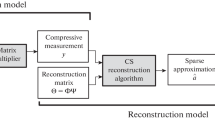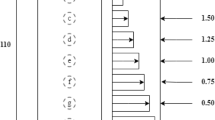Abstract
Active infrared thermography (AT) has been evolved as a prominent nondestructive testing technique for in-situ monitoring of defect-free composite material manufacturing. The recent past witnessed the growth of low peak power nonstationary thermal wave imaging schemes to provide a promising axial and spatial resolution to cater for these requirements. The present article employs a proper orthogonal decomposition (POD) for the processing of quadratic frequency modulated thermal waves intended to enhance the detection of subsurface anomalies by using selective mode consideration. The performance of POD is experimentally validated over carbon fiber and glass fiber reinforced plastic specimens with artificially created flat bottom holes and Teflon inclusions considered to be the subsurface anomalies. Further, the enhanced defect detection capabilities of POD are qualitatively assessed using signal-to-noise ratio and size of defects as a figure of merit.










Similar content being viewed by others
REFERENCES
Maldague, X.P.V., Theory and Practice of Infrared Technology for Non-Destructive Testing, New York: Wiley, 2001.
Ibarra-Castanedo, C., Marc Genest, Servais, P., Xavier P.V. Maldague, and Bendada, A., Qualitative and quantitative assessment of aerospace structures by pulsed thermography, Nondestr. Test. Eval., 2007, vol. 22, nos. 2-3, pp. 199–215.
Pickering, Simon and Darryl Almond, Matched excitation energy comparison of the pulse and lock-in thermography NDE techniques, NDT & E Int., 2008, vol. 41, no. 7, pp. 501–509.
Ranjit Shrestha, Yoonjae Chung, and Wontae Kim, Thermal behavior variations in coating thickness using pulse phase thermography, J. Kor. Soc. Nondestr. Test., 2016, vol. 36, no. 4, pp. 259–265.
Suresh, B., Subhani, S.K., Vijayalakshmi, A., Vardhan, V.H., and Ghali, V.S., Chirp Z transform based enhanced frequency resolution for depth resolvable non stationary thermal wave imaging, Rev. Sci. Instrum., 2017, vol. 88, no. 1, p. 014901.
Subhani, S.K., Suresh, B., and Ghali, V.S., Quantitative subsurface analysis using frequency modulated thermal wave imaging, Infrared Phys. Technol., 2018, vol. 88, pp. 41–47.
Shi Qianzhu, Junyan Liu, Wanyu Liu, Fei Wang, and Yang Wang, Barker-coded modulation laser thermography for CFRP laminates delamination detection, Infrared Phys. Technol., 2019, vol. 98, pp. 55–61.
Subhani, S.K., Suresh, B., and Ghali, V.S., Empirical mode decomposition approach for defect detection in non-stationary thermal wave imaging, NDT & E Int., 2016, vol. 81, pp. 39–45.
Subhani, S.K., Suresh, B., and Ghali, V.S., Orthonormal projection approach for depth-resolvable subsurface analysis in non-stationary thermal wave imaging, Insight Nondestr. Test. Cond. Monit., 2016, vol. 58, no. 1, pp. 42–45.
Subhani Shaik, Gampa VP Chandra Sekhar Yadav, and Venkata Subbarao Ghali, Defect characterization using pulse compression-based quadratic frequency modulated thermal wave imaging, IET Sci. Meas. Technol., 2019, vol. 14, no. 2, pp. 165–172.
Subhani, S.K. and Ghali, V.S., Measurement of thermal diffusivity of fiber reinforced polymers using quadratic frequency modulated thermal wave imaging, Infrared Phys. Technol., 2019, vol. 99, pp. 187–192.
Lakshmi, A. Vijaya, Gopitilak, V., Muzammil M. Parvez, Subhani, S.K., and Ghali, V.S., Artificial neural networks based quantitative evaluation of subsurface anomalies in quadratic frequency modulated thermal wave imaging, Infrared Phys. Technol, 2019, vol. 97, pp. 108–115.
Lakshmi, A. Vijaya, Ghali, V.S., Subhani, S.K., and Naik R. Baloji, Automated quantitative subsurface evaluation of fiber reinforced polymers, Infrared Phys. Technol., 2020, vol. 110, p. 103456.
Tilak, V. Gopi, Ghali, V.S., A. Vijaya Lakshmi, Suresh, B., and Naik, R.B., Proximity based automatic defect detection in quadratic frequency modulated thermal wave imaging, Infrared Phys. Technol., 2021, vol. 114, p. 103674.
Vesala, G.T., Ghali, V.S., A. Vijaya Lakshmi, Suresh, B., and Naik, R.B., Deep and handcrafted feature fusion for automatic defect detection in quadratic frequency modulated thermal wave imaging, Russ. J. Nondestr. Test., 2021, vol. 57, no. 6, pp. 476–485.
Chatterjee, Anindya, An introduction to the proper orthogonal decomposition, Current Sci., 2000, pp. 808–817.
Kaur, K., Sharma, A., Rani, A., Kher, V., and Mulaveesala, R., Physical insights into principal component thermography, Insight Nondestr. Test. Cond. Monit., 2020, vol. 62, no. 5, pp. 277–280.
Berkooz Gal, Holmes, P., and John L. Lumley, The proper orthogonal decomposition in the analysis of turbulent flows, Annu. Rev. Fluid Mech., 1993, vol. 25, no. 1, pp. 539–575.
Garg Sushil, Balaji R. Sharma, Kelly Cohen, and Manish Kumar, A proper orthogonal decomposition based algorithm for smoke filtering in videos, 2013 Am. Control Conf., pp. 3529–3534.
Falkiewicz, Nathan J., and Carlos E.S. Cesnik, Proper orthogonal decomposition for reduced-order thermal solution in hypersonic aerothermoelastic simulations, AIAA J., 2011, vol. 49, no. 5, pp. 994–1009.
Xiao Tengfei, Xiao-Dong Li, and Shuqiang Wang, Dominant-modes-based sliding-mode observer for estimation of temperature distribution in rapid thermal processing system, IEEE Trans. Ind. Inf., 2018, vol. 15, no. 5, pp. 2673–2681.
Berardi, V., Carretero-González, R., Klepeis, N.E., Palacios, A., Bellettiere, J., Hughes, S., Obayashi, S., and Hovell, M.F., Proper orthogonal decomposition methods for the analysis of real-time data: Exploring peak clustering in a secondhand smoke exposure intervention, J. Comput. Sci., 2015, vol. 11, pp. 102–111.
Vesala, G. T., Ghali, V. S., Subhani, S., and Y. Naga Prasanthi, Material characterisation by enhanced resolution in non-stationary thermal wave imaging, Insight-Non-Destructive Testing and Condition Monitoring, 2021, vol. 63, no. 12, pp. 721–726.
Funding
The Naval Research Board, India partly supports this work, under grant no. NRB-423/MAT/18-19.
Author information
Authors and Affiliations
Corresponding author
Ethics declarations
The authors declare that they have no conflicts of interest.
Rights and permissions
About this article
Cite this article
Vesala, G.T., Ghali, V.S., Subhani, S. et al. Enhanced Subsurface Analysis Using Proper Orthogonal Decomposition in Nonstationary Thermal Wave Imaging. Russ J Nondestruct Test 57, 1027–1038 (2021). https://doi.org/10.1134/S1061830921110103
Received:
Revised:
Accepted:
Published:
Issue Date:
DOI: https://doi.org/10.1134/S1061830921110103




